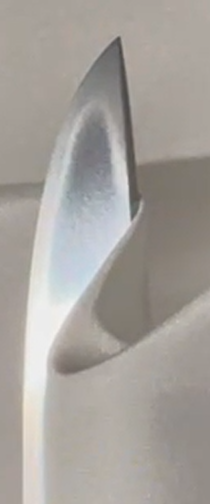-
Posts
1,530 -
Joined
-
Last visited
-
Days Won
5
Content Type
Profiles
Forums
Events
Store
Downloads
Gallery
Everything posted by Lewis B
-
Juyo or TJ yes, not sure about TH or Hozon.
-
Did they chisel out the hamon? Or just very poor forging? Crazy
-

Dai Token Ichi this weekend!
Lewis B replied to MassiveMoonHeh's topic in General Nihonto Related Discussion
Not sure I can agree with you there. The boshi are impossible to see and all the photos are taken perpendicular to the blade which is less than ideal to see activity in the jihada. Resolution is good though. Best images now that Darcy's Yuhindo is no longer available are to be found on Pablo's Unique Japan IMO. This may be controversial but I think Touken Komachi gives it a very good go. Just a shame they stock mostly low end pieces. -

Dai Token Ichi this weekend!
Lewis B replied to MassiveMoonHeh's topic in General Nihonto Related Discussion
Did anyone buy a sword at the DTI this year? How were the prices in 2025 vs previous years? -
Thats a little sad to hear given the quality of the blades and katchu, the Nagoya Token World has accumulated. I have to say the Samurai Museum in central Berlin was not great either for studying blades. The angles were less than ideal and the lighting failed to illuminate the jihada and hataraki adequately, especially for the blades in the cabinets along the wall. Oddly the central display cabinet was quite good in comparison and it was easy the see the activity and get close to the blade to observe the detail. Given the obvious time and effort put into the general display design for armour, nihonto seemed overlooked.
-
Posted this query in another thread but maybe the right eyeballs didn't catch it. It was referring to the style of hamon that blended notare and suguha hamon styles. I read the samurai of the time valued this style of hamon. https://www.samurai-nippon.net/SHOP/V-2153.html There is a technical term for the style of hamon that transitions from notare in the central section to more suguha style in the monouchi that eludes me. As I understand it this was the intent of the smith for practical reasons and was a ferature prized by the samurai of the time, as it strengthens the area of the blade that is more likely to contact the opponents blade. And how did the smith achieve this effect? Is it simply a differential hardening exercise using different clay applications? What is the name given to this style of hamon that appeared popular during the Kamakura era and especially noteworthy in Bizen swords.
-

Dai Token Ichi this weekend!
Lewis B replied to MassiveMoonHeh's topic in General Nihonto Related Discussion
Anyone notice the listing price for the Den Sukezane ? -

Dai Token Ichi this weekend!
Lewis B replied to MassiveMoonHeh's topic in General Nihonto Related Discussion
Another interesting blade that sold very quickly attributed to Den Sukezane https://www.samurai-nippon.net/SHOP/V-2153.html There is a technical term for the style of hamon that transitions from notare in the central section to more suguha style in the monouchi that eludes me. As I understand it this was the intent of the smith for practical reasons, as it strengthens areas of the blade that is more likely to contact the opponents blade. -

Dai Token Ichi this weekend!
Lewis B replied to MassiveMoonHeh's topic in General Nihonto Related Discussion
Some very nice, big name blades hitting the dealer sites now that the DTI is over for another year. Take this Rai Kunitoshi with a 83cm nagasa for example. https://eirakudo.shop/893683?fbclid=IwY2xjawN8o41leHRuA2FlbQIxMABzcnRjBmFwcF9pZBAyMjIwMzkxNzg4MjAwODkyAAEeLQq1a5LF0_auFK8Lfzf8ISvUcl-l-IbEOqlzlAbPNdLOLAkEdhB4DXdNaBw_aem_BP-p-U1Dmg9Vtxt31T2kTA -

Help regarding the Bigelow collection
Lewis B replied to markturner's topic in General Nihonto Related Discussion
Last visited 2020. -
I'm eating in the wrong restaurants.
-

Dai Token Ichi this weekend!
Lewis B replied to MassiveMoonHeh's topic in General Nihonto Related Discussion
How much is Eirakudo asking and how prominent is the midare utsuri? -
@Lexvdjagt kindly sent me a short video and photo of the nakago of an exceptional Shintogo Kunimitsu tanto currently on display at the Japanese Sword Museum in Tokyo. This one was posthumously bequeathed to the museum from the Suzuki collection. The tanto itself is probably one of the best examples I've seen. The deki is archetypical Shintogo, ubu with a nengo for 1316. The nagasa is 21.9cm with a slender sugata. There are beautiful lines of kinsuji, one of the key features of this smiths work. Overall it appears to be a very healthy, original example. If the NBTHK published something about this blade it would be interesting to see. Setsumei, kantei etc?
-

Dai Token Ichi this weekend!
Lewis B replied to MassiveMoonHeh's topic in General Nihonto Related Discussion
I was hoping to attend but the German Gov have been dragging their feet processing my Settled Status application, which meant I couldn't travel outside Germany. Oh well 2026 then..... Everyone have fun and if you happen see that "Shintogo" tanto (#55) on the Ginza Japanese Sword Museum Taibundo stand, please let us know what you think. Do the papers attribute the blade specifically to Shintogo or are they less specific. The dealer has ignored efforts to get more info via email. -
Here is a tachi blade worthy of consideration if you're interested in Ko-mihara. Ubu, zaimei, nengo (1384), quality koshirae and fittings. Juyo papers. Approx 80cm nagasa https://www.toukentakarado.com/item-tk019-juyo-token-mihara
-

catching out Jauce on there bullshit
Lewis B replied to lonely panet's topic in Auctions and Online Sales or Sellers
Could be a case of a 3rd party hijacking the real sellers listing and making a profit on the actual sales price. 3rd party buys for 17,300 and sells for 35,300 JPY. Seems like a lot of work for little reward. Happens a lot on Ebay where items the seller doesn't have get posted for 30%+ more than the item can be bought for on Jauce/Yahoo.jp auction site. -
Well, it depends. He won't say in writing but the person who collects it after getting the sayagaki could ask for his opinion and, assuming he has a friendly relationship with the dealer, you should have a good idea where it stands. The sayagaki could also give you an indicator. If he writes it's a masterpiece amongst the work of the smith it's a good start. But obviously its not a sure thing. Recent Juyo Shinsa have been 'strange' to say the least.
-
That great news. Make sure the dealer asks Tanobe sensei if it has a chance at Juyo and you can make an educated decision if it's worth being without the sword for a prolonged period. With the current shipping uncertainty and that the blade is currently in Japan I'd be more inclined to submit to Shinsa if Tanobe responds positively.
-
I assume someone in Japan would act as an agent for submission, retrieval and subsequent relocation. Since Sky is buying from a big name dealer in Tokyo I would hope they would agree to provide that service (perhaps for a fee).
-

Help With Approximate Age and Sugata of Blade with Partial Signature KUNI
Lewis B replied to tbonesullivan's topic in Nihonto
It has katana mei so that would put it early Muromachi at the earliest. Could be an earlier blade but later signature. -
So says the "informed amateur"
-

Looking for thoughts on this Rai Kunitsugu marked blade.
Lewis B replied to Brian Dent's topic in Nihonto
Chicago isn't too far for you. Take it to the next show to be checked out by knowledgeable eyes. -
Juyo shinsa happens once a year in October. If it fails it'll likely be released towards end of the year. If it passes you have to wait for the papers and oshigata to be completed. You won't see it again until early 2027. Obviously worth the wait in the latter instant











